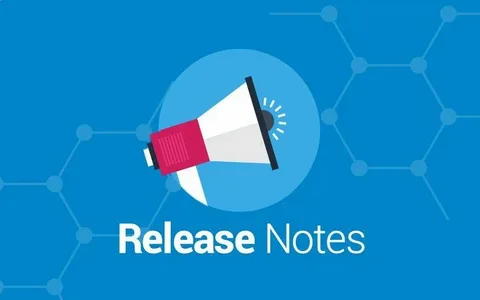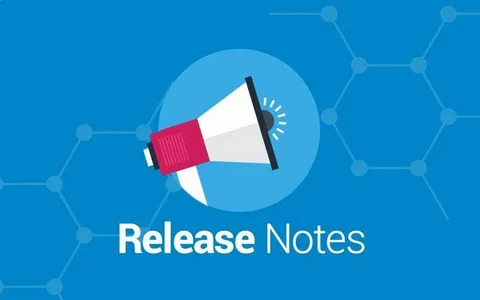Release Notes: A Comprehensive Guide for Software Updates
In the world of software development and IT management, release notes play a crucial role in ensuring users understand the changes made to a software product during its new version release. These notes provide a clear, concise summary of the updates, enhancements, bug fixes, and any other modifications in a new version of software or an application. Whether for small updates or major releases, release notes serve as the bridge between developers and end users, helping to ensure smooth adoption of the new version.
In this article, we’ll delve into the purpose, importance, structure, and best practices for writing and distributing release notes, as well as the tools commonly used to manage them.
What Are Release Notes?
Release notes are detailed documents that accompany the release of a new version of software. They describe the changes made to the software, including:
- New Features: Descriptions of new functionalities or capabilities added in the latest version.
- Bug Fixes: Issues that have been addressed, resolved, or fixed.
- Improvements: Enhancements to existing features or codebase for better performance, security, or usability.
- Breaking Changes: Any changes that may affect backward compatibility or require users to modify their existing workflows.
- Known Issues: Any problems or bugs that remain unresolved in the current release.
- Deprecations: Features or functionalities that are being phased out or removed in the new release.
Release notes often contain version numbers, the release date, and links to additional documentation for developers or users who need more information.
Why Are Release Notes Important?
Release notes are an essential part of the software development lifecycle, serving several important functions for different stakeholders:
1. User Awareness
Release notes inform users about what has changed in the latest version of software. Whether it’s a minor update, a bug fix, or a major feature addition, users need to be informed to fully understand the impact of the update on their workflow or experience.
- New Features: Users can take advantage of the new functionalities and understand how to use them.
- Bug Fixes: Users are made aware of issues that have been resolved, improving the overall experience.
- Performance Improvements: Users learn about improvements that may enhance software stability and speed.
2. Transparency and Trust
Release notes are a transparency tool that allows software providers to communicate openly about the changes made to a product. This transparency builds trust with users, as they can clearly see what has been modified, fixed, or enhanced.
3. Support and Troubleshooting
Release notes are valuable resources for IT support teams and developers. By referencing the release notes, they can quickly identify whether a particular issue is tied to a known bug or a newly introduced feature. This helps with troubleshooting and responding to user queries effectively.
4. Compliance and Documentation
For businesses that are required to follow specific regulatory requirements or best practices, release notes provide a documentation trail of all updates and changes made to a software product. This can be useful for auditing, compliance reporting, or tracking version histories.
5. User Education
By explaining the “why” and “how” of a change, release notes also serve as educational tools. They provide users with the context behind new features or fixes and help them understand how to make the most of the update.

Common Elements of Release Notes
While the structure of release notes can vary from one organization to another, most follow a similar template. Below are the key components typically included in release notes:
1. Version Number and Release Date
Each release note starts with a version number (e.g., v1.2.3) and the release date. The version number helps differentiate between different updates, and the release date indicates when the changes became available to the public.
2. Overview of the Release
This section provides a brief summary of the release, highlighting the major changes, such as new features, fixes, or improvements. It serves as an introduction, offering readers a high-level overview of what’s new or different in the version.
3. New Features and Enhancements
Here, the release notes detail the new functionalities added to the software. It may include user interface changes, new tools, or capabilities. The goal is to give users an idea of how these features improve the product and what value they bring.
4. Bug Fixes and Issues Resolved
This section outlines the bugs and errors that have been resolved in the new version. It’s important to explain the impact of each fix and how it improves user experience. Often, this section will include a list of common user complaints or technical issues that have been addressed.
5. Known Issues
Known issues are bugs or limitations that were not resolved in this release but may be addressed in future updates. Including known issues is important because it sets user expectations and prevents confusion when they encounter problems that haven’t been fixed yet.
6. Breaking Changes or Deprecations
If a software update involves changes that could break compatibility with older versions or third-party integrations, this should be clearly outlined in the release notes. Deprecation of features also needs to be highlighted so that users can prepare for upcoming changes.
7. Installation and Upgrade Instructions
While this is not always included in the release notes themselves, some updates (especially major ones) may require specific installation instructions or upgrade steps. Providing guidance on how to install the new version or migrate from older versions can be incredibly helpful for users.
8. Additional Resources
Some release notes will link to additional resources, such as detailed documentation, user manuals, FAQs, or community forums. These links are helpful for users who want further information or need help troubleshooting.
Best Practices for Writing Release Notes
To ensure that release notes are effective, clear, and helpful, it’s important to follow best practices when drafting them:
1. Be Clear and Concise
Release notes should be easy to understand. Avoid overly technical jargon unless the audience is developers or system administrators. Write in plain language that everyone can follow, focusing on clarity.
- Example: Instead of saying “Refactored the user management module,” write “We’ve made improvements to the user management system, making it faster and easier to add new users.”
2. Use Bullet Points
Where appropriate, use bullet points to list new features, bug fixes, and known issues. This makes it easier for users to quickly scan and find relevant information.
3. Prioritize Information
Place the most important information at the top, such as critical security patches or major new features. Less important changes, such as minor bug fixes or optimizations, can be listed lower down.
4. Use Version Control for Changes
For teams using version control systems (like Git), maintain detailed change logs to document what’s changed with each update. These can form the basis for your release notes and ensure all changes are tracked systematically.
5. Provide Context
Where applicable, provide context for why changes were made. For instance, if a feature was removed, explain why it was deprecated or how it will be replaced. Similarly, if a bug was fixed, offer a brief description of how it impacted users.
6. Link to Further Documentation
Link to more detailed release notes or guides for those who want in-depth explanations, especially when the release includes substantial new features or complex changes. This helps avoid overwhelming less technical users while providing more advanced users with the information they need.
7. Proofread and Test
Always proofread your release notes before publishing. Mistakes in the release notes can lead to confusion or make users question the reliability of the update itself. Make sure the release notes are accurate and complete, especially when it comes to bug fixes and known issues.
8. Be Honest About Limitations
Honesty is key when creating release notes. If there are known issues that users may encounter, be upfront about them. It’s better to set expectations clearly than to leave users frustrated when they encounter problems that were not disclosed.
Tools for Managing and Distributing Release Notes
Many tools are available to assist developers in managing and distributing release notes efficiently:
1. GitHub/GitLab/Bitbucket
Version control platforms like GitHub, GitLab, and Bitbucket allow developers to track changes and generate release notes from commit history. These platforms can automatically generate changelogs that summarize the changes between versions.
2. JIRA
JIRA, a project management tool from Atlassian, is widely used in software development teams to track bugs, tasks, and updates. It can integrate with other tools and automatically create release notes based on completed issues or user stories.
3. Trello
Trello is another project management tool that can help teams track and organize tasks, and it can be used to manage the process of writing release notes. By using labels, cards, and boards, teams can easily document changes and share them with stakeholders.
4. Confluence
Confluence, also from Atlassian, is a collaborative documentation platform. Teams can create detailed release notes in Confluence and link them to relevant Jira tickets or other documentation.
5. Automated Changelog Generators
Several tools, such as Release Drafter, Keep a Changelog, and GitVersion, can help automate the creation of changelogs or release notes by extracting data from version control systems and issue tracking systems.
Conclusion
Release notes are an essential part of the software release process. They provide users with a clear and concise explanation of what has changed in the latest version of software, including new features, bug fixes, known issues, and any breaking changes. Well-written release notes not only improve user experience but also help build trust and transparency between developers and end users.
For developers, release notes are more than just a formality—they are an opportunity to communicate the value of new updates, enhance user satisfaction, and support efficient troubleshooting. By following best practices and using the right tools, teams can ensure that their release notes are informative, user-friendly, and valuable to all stakeholders involved.

